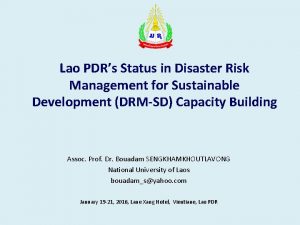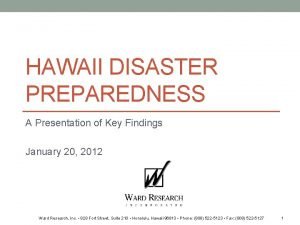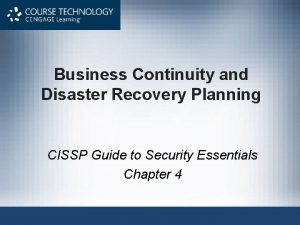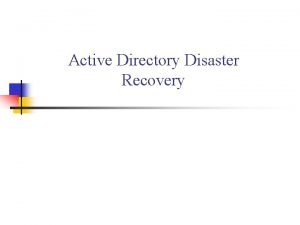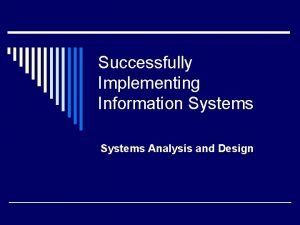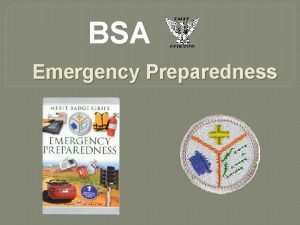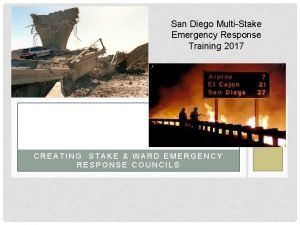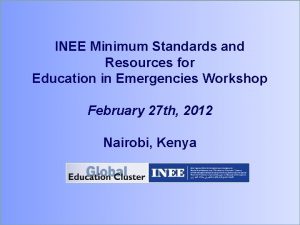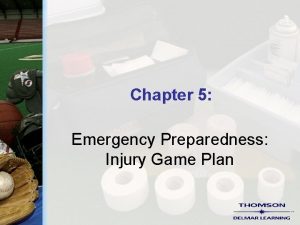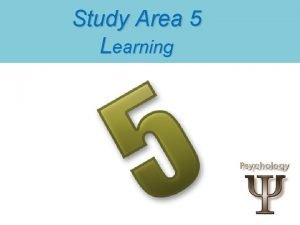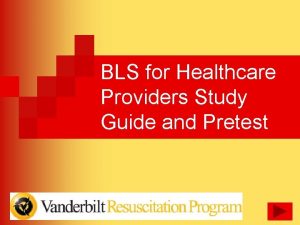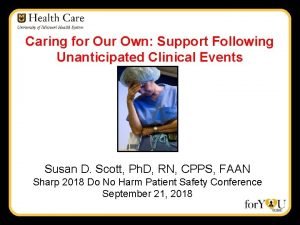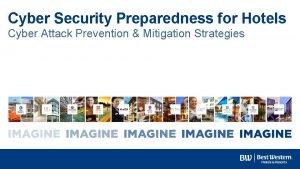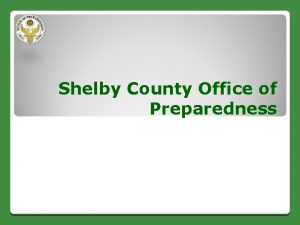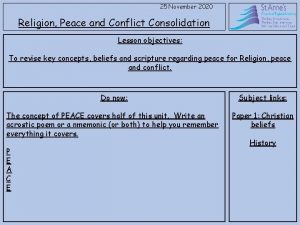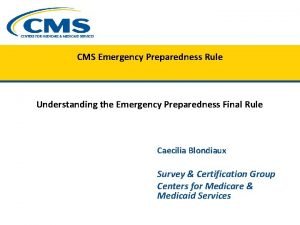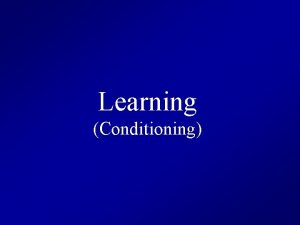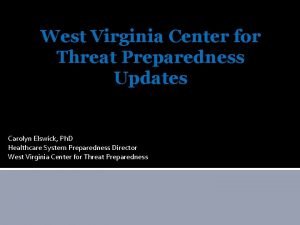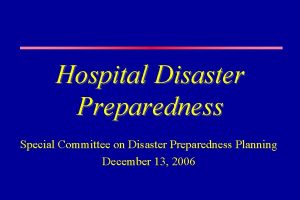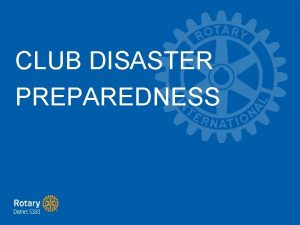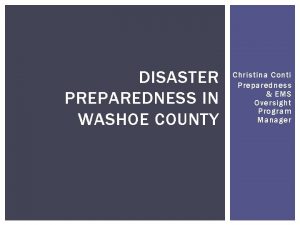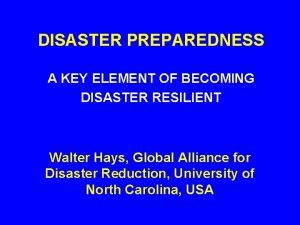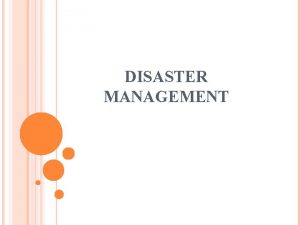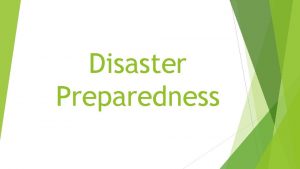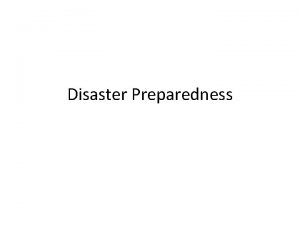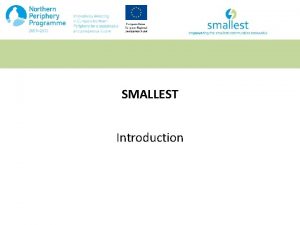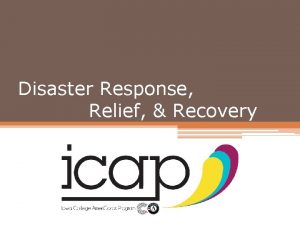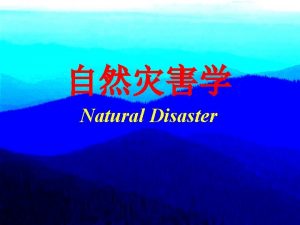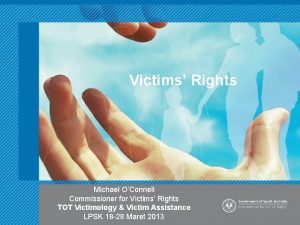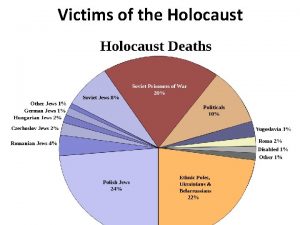THE SMALLEST VICTIMS Disaster Preparedness Planning for Children





























































- Slides: 61

THE SMALLEST VICTIMS: Disaster Preparedness Planning for Children Kay Koelemay, MD, MPH Public Health – Seattle & King County Partners in Emergency Preparedness Conference Tacoma, Washington April 1 -2, 2008 April 2008

The Child Emergency Plan April 2008

Katrina – August 29 th, 2005 April 2008

Reunification – March 17, 2006 April 2008

Minnesota Bridge April 2008

Windstorms and Floods April 2008

Disaster Planning for Kids ? April 2008

Children: Not “Small Adults” • Anatomical/ physiological differences • Vital signs vary with age • Smaller, shorter stature – lower “breathing zones” • Higher minute volume • Less intravascular volume reserve April 2008

Uniquely Vulnerable • • Greater body surface area to weight ratio Increased skin permeability More pliable skeleton Weight is critical in determination of: – drug dosages – fluid requirements – equipment sizes April 2008

Example: Decontamination of Children • • • Must be done with high-volume, low-pressure, heated water systems Must be designed for decontamination of all ages and types of children All protocols and guidance must address: – – April 2008 Water temperature and pressure Nonambulatory children Children with special health care needs Clothing for after decontamination

Decon Shower- Child Decon Shower- Infants & nonambulatory kids Pediatric Disaster Toolkit: Hospital Guidelines for Pediatrics in Disasters http: //www. nyc. gov/html/doh/html/bhpp-focus-ped-toolkit. shtml April 2008

From a Child’s Perspective? April 2008

Developmental Differences • Preverbal cannot describe symptoms or relate identifying information • Dependent on others for food, clothing, shelter • Motor skills may deter escape from site of incident • Cognitive development may limit abilities: – How to flee from danger – How to follow directions – How to recognize a threat April 2008

Katrina: Biloxi April 2008

Mental Health Issues • Issues are developmentally dependent • Short- and long-term manifestations – PTSD, fear, depression, sleep disturbances, social or behavioral difficulties, anxiety, changes in school performance • Related to parental reaction – Family-centered approach recommended • Certain children may be more vulnerable – Children with pre-existing mental health problems – Low income and racial or ethnic minorities April 2008

• There is no “ground zero” for the psychological effects of a disaster. • Exposure to repetitive images or reports on TV or in other media should be limited. April 2008

Gaps in Pediatric Planning April 2008

The Model State Emergency Health Powers Act (2002) • American Academy of Pediatrics responds to Centers for Disease Control & Prevention (CDC) – Children: more vulnerable than adults during terrorist attacks or other disasters – Children: unique treatment needs, once critically ill or injured – Children: significant mental health needs April 2008

National Conference - 2003 April 2008

April 2008

Conference Recommendations: Pediatric Planning in 8 Major Areas • • Pre-hospital care Hospital care Emergency preparedness Terrorism preparedness and response Mental health needs School preparedness and response Training and drills Future research agenda and funding April 2008

Federal Response Efforts Related to Children • Health Resources and Services Administration – National Advisory Committee on Children and Terrorism • 2003 report: http: //www. bt. cdc. gov/children/#what – Trauma/Emergency Medical Services Program • not funded in 2006 – Poison Control Centers • funding cut in half in 2007 – Emergency Medical Services for Children • not funded in 2007 April 2008

Federal Response Efforts Related to Children • Disaster Medical Assistance Teams – Two (2) pediatric teams in the country • Atlanta and Boston • Strategic National Stockpile – As of 2006, only 10% of oseltamivir is available in suspension form • Capsule form for young children – Antidotes and medications are not available in pediatric-approved dosages and preparations April 2008

Unmet Needs • Comprehensive, school-based emergency preparedness protocols • Pediatric protocols in every hospital • Pediatric surge capacity plans • Education/training on unique issues • Community involvement • Identification and reunification of children and parents April 2008

Emergency and Pre-hospital Care • Use of pediatric-specific triage system by all first responders – Jump. START • www. jumpstarttriage. com/Jump. START_and_MCI_Triage. php – PEPP (Pediatric Education for Prehospital Professionals) • www. peppsite. com/ • Equip EMS personnel and response vehicles with pediatric-specific equipment and meds • Encourage development of DVDs and videos as training tools April 2008

Hospital Care • Ensure preparedness for care of children in all hospitals in disaster response – Augment role of children’s hospitals • Provide specialty resources and counsel for general hospitals • Maintain 72 hours of pediatric supplies and pharmaceuticals based on average daily census plus minimum surge of 5% • Include pediatric component in Web-based hospital resource availability networks • Hospital Bed Capacity April 2008

New HHS/AAP Resource “Pediatric Terrorism and Disaster Preparedness: a Resource for Pediatricians” – Agency for Health and Research Quality (AHRQ) • Office of Public Health Emergency Preparedness • Health Resources and Services Administration – American Academy of Pediatrics (AAP) – http: //www. ahrq. gov/research/pedprep/ (354 pp. ) – http: //www. ahrq. gov/research/pedprep/pedtersum. htm April 2008

Katrina: Lessons Learned • Mobile Pediatric Emergency Response Teams – Pre-assigned is preferable to just- in-time volunteers – Relieve local Emergency Departments – Provide trained pediatric care • Mental health and social services ASAP • Sheltering families/children requires special planning • Emergency credentialing needs streamlining • Centrally located functional communication device is crucial (phone, cell phone, radio) • Do not expect distant assistance soon, if at all April 2008

Where Do We Start? April 2008

Get Prepared at Home ASK YOURSELF: “What do I need to take care of now to make sure that I can report to work during a health emergency? ” April 2008 Have a Family Emergency & Disaster Plan !

Get Prepared at Home and at Work • Store extra supplies: – water, food, health supplies • Get an extra supply of prescription drugs • Create a list of your family’s health information • Include children in planning – Should know their roles in an emergency – Have drills and review specifics of plan April 2008

“The most frequently cited reason for employees’ unwillingness to report to duty during a disaster was fear and concern for the safety of their families and themselves. ” Qureshi K, Gershon RRM, Sherman MF et al. Health care workers’ ability and willingness to report to duty during catastrophic disasters. Journal of Urban Health: Bulletin of the New York Academy of Medicine. 2005; 82 (3): 378 -88. April 2008

Planning for Evacuation • Teach children their phone number and address as early as possible • Designate an out-of-area contact to call • Create a “Go Kit” (that means portable!) – Water, food, shelter, meds, other essentials – Include recent photo of children – Permanent marker • Write essential info about child on his/her arm • Include family pets in emergency planning April 2008

Emergency Preparedness • Planning must consider: – Children at home, in school or daycare – Children in transit – Children who cannot be reunited with their families • Involve pediatric experts in all facets of regional and statewide disaster planning April 2008

Washington State Schools • Substitute Senate Bill 5097 (May, 2007) – All districts: a “safe school” plan by 9/1/08 – Transportation/evacuation procedures • • • Bus staging areas Evacuation routes Communication systems Parent-student reunification sites Secondary transportation agreements – Plan with local emergency responders – Drills, reporting requirements, ICS training April 2008

Sheltering Families with Children • Special equipment – Cribs, bottles, pacifiers, infant seats, strollers, clothing • Special foods – Formula (ready-to-feed) – Toddler foods • Sanitation issues – Diapers and child-friendly toilet facilities – Waterless hand sanitizer April 2008

Sheltering Families with Children • Health, safety and supervision – ID bracelets for women and their children – Potential exposures, e. g. , adult medications – Pediatric propensity to disease • Methods to distract, entertain and comfort – Both for their sakes and the sake of others • Environmental concerns – Smoking, alcohol and other drugs – Weapons April 2008

Children with Special Health Care Needs and Disabilities • Prevalence: 1 in 8 children • Range of needs* – – – Prescription meds (75%) Increased level of care (46%) Emotional or behavioral services (29%) Limitation of activities (21%) Requirement for special therapies/equipment (17%) • Encourage families to – Emergency medical information form – Copies of important medical records *HHS (2001) www. mchb. hrsa. gov/chscn/index. htm April 2008

Displaced Children • Temporary shelter, potentially for a large group • Plans for reuniting with families • Guardianship, when parents are injured or deceased – System to notify next of kin – Crisis counseling – Translation services April 2008

Identification and Reunification • Requires means of rapidly collecting information on arriving casualties – Consider digital photos – Photo indexing • Create system to reunite families – Site where arriving parents can review photos – Website or hotline – Out-of-state contact in medical and school records April 2008

Mental Health Services • As soon as possible, children need: – Opportunities to express their feelings – An environment where they feel safe – A sense of normalcy • Sense of safety comes from adult cues – Provide intervention to parents and caregivers, as necessary • Provide predictable routine and consistent support system, e. g. , school • Provide an opportunity for them to help April 2008

Lower Ninth Ward - NOLA April 2008

"I see these pictures in my head and I can make my pencil look like them. I see the details of things. . . now, sometimes I wish I didn't. “ Donald, age 12 April 2008

Pets in Emergencies April 2008

Planning for Pets Make back-up plan with neighbor (house key) Evacuate pets, whenever possible • Keep list/ phone #’s of “pet friendly” places – Given notice, call ahead for reservation • Ask friends/ relatives outside affected area • Make list of boarding facilities/ veterinarians – Include 24 -hour phone # • Animal shelters should be last resort April 2008

Portable Pet Disaster Kit • • • Medical records and any medications Sturdy leashes and/or carriers with ID label Current photos, in case they get lost Food and potable water (7 -day supply) Bowls, can opener, cat litter and pan, first-aid kit Information card: – – Feeding schedules Medical conditions Behavior problems Veterinarian’s name and phone # April 2008

At the First Hint of Disaster… • • Call to confirm shelter arrangements Check pet disaster supplies Bring all pets into the house Make sure they are wearing collars – Securely fastened – Up-to-date identification – Phone #/ address of temporary shelter – Phone # of friend or relative outside the area April 2008

“Children are dependent upon the good decision-making of their caregivers. They should be subjected to the lowest amount of risk possible. ” Garrett et al. Children and megadisasters: lessons learned in the new millennium. Advances in Pediatrics, 2007 April 2008

“Somebody wants to know if we have carried out a thorough risk assessment” April 2008

Pediatric Workgroup Steering Committee with Task Forces • Communication • Children with special needs & disabilities • Triage/ critical care • Perinatal issues April 2008 • Schools/ daycare facilities • Medication issues • Alternate care facilities • Palliative care

Pediatric & Perinatal Resources • Surge capacity vs. capability – Beds, staff and equipment – Care of non-disaster-related patients – Geographic distribution of resources • Hazard vulnerability assessment – Infrastructure – Transportation • Credentialing for sharing staff April 2008

King County Regional Emergency Coordination Zones April 2008

Pediatric Hospital Beds A April 2008

Pediatric Resources by Emergency Response Zone April 2008 *Source: 2005 Population Estimates for Public Health Assessment, Washington State Department of Health.

Residence vs. Place of Childbirth by Emergency Response Zone April 2008 Data Source: Birth Certificate Data 2005: Washington State Department of Health, Center for Health Statistics

Pediatric Input Is Essential • Influence all aspects of response planning – Local, regional and state levels • Organize pediatric providers to ensure appropriate distribution of expertise • Work with first responders, schools and regional hospitals on immediate response • Develop triage system that ensures appropriate care, shelter, tracking ID April 2008

Resources • Emergency Information Form for Children with Special Needs – http: //www. aap. org/advocacy/blankform. pdf • Family Readiness Kit (35 pp. ): – http: //www. aap. org/family/frkit. htm • Four Steps to Prepare Your Family for Disasters (2 pages of Readiness Kit): – http: //www. aap. org/family/frk/FOursteps. FRK. pdf • Spanish version (13 pp. ): – http: //www. aap. org/family/frk/FRK-Spanish. pdf April 2008

More Resources • American Red Cross Preparedness Information – 13 translations – online preparedness training module – http: //www. prepare. org/ • ARC Community Disaster Education Materials Listed by Hazard – including 27 Things To Do To Get Ready for an Earthquake prepared by the Los Angeles Chapter of ARC – available in 10 languages: – http: //www. redcross. org/pubs/dspubs/cdelist. html April 2008

Still More Resources • Public Health Emergencies: Strategies and tools for meeting the needs of children – web conference – http: //www. ahrq. gov/news/ulp/btpediatric • Decontamination of Children: Preparedness and Response for Hospital Emergency Departments – video – http: //www. ahrq. gov/research/decontam. htm April 2008

It’s Not Just a Fable! The Grasshopper and the Ants If an unforeseen emergency occurs, will you find yourself April 2008 ready…or not?

Thank you very much! Questions or Comments? Kathryn. Koelemay@kingcounty. gov April 2008
 Disaster preparedness conclusion
Disaster preparedness conclusion Hawaii disaster preparedness
Hawaii disaster preparedness Cissp business continuity plan
Cissp business continuity plan Active directory disaster recovery best practices
Active directory disaster recovery best practices Disaster recovery planning in system analysis and design
Disaster recovery planning in system analysis and design Perbedaan irp, drp dan bcp
Perbedaan irp, drp dan bcp Bsa emergency preparedness
Bsa emergency preparedness Stake emergency preparedness plan
Stake emergency preparedness plan Implementing nfpa 1600 national preparedness standard
Implementing nfpa 1600 national preparedness standard Victimology
Victimology Preparedness mitigation response recovery
Preparedness mitigation response recovery Hammock carry
Hammock carry West memphis 3 crime scene photos
West memphis 3 crime scene photos Chapter 5 emergency preparedness injury game plan
Chapter 5 emergency preparedness injury game plan Nfpa 1600 business continuity programs
Nfpa 1600 business continuity programs Psychological types of victims
Psychological types of victims Victims
Victims Joe tinning today
Joe tinning today Hyatt regency walkway collapse
Hyatt regency walkway collapse Word formation fashion
Word formation fashion Do. 27 s. 2015 promoting family earthquake preparedness
Do. 27 s. 2015 promoting family earthquake preparedness Global pandemic preparedness
Global pandemic preparedness Drowning victims
Drowning victims Biological preparedness
Biological preparedness Thourghout
Thourghout Biological preparedness
Biological preparedness After positioning yourself directly above the victims head
After positioning yourself directly above the victims head Chapter 36 emergency preparedness and protective practices
Chapter 36 emergency preparedness and protective practices Canadian centre for victims of torture
Canadian centre for victims of torture Axel johanson
Axel johanson Insight learning theory
Insight learning theory 3 tiers of support for second victim
3 tiers of support for second victim Contribution of hans von hentig in victimology
Contribution of hans von hentig in victimology Hotel cyber security
Hotel cyber security Shadows of hiroshima victims
Shadows of hiroshima victims What are disasters
What are disasters National radiological emergency preparedness conference
National radiological emergency preparedness conference Shelby county office of preparedness
Shelby county office of preparedness Richard chase macaroni
Richard chase macaroni Religious beliefs about helping victims of war
Religious beliefs about helping victims of war Canadian centre for victims of torture
Canadian centre for victims of torture Cms emergency preparedness final rule
Cms emergency preparedness final rule Chapter 36 emergency preparedness and protective practices
Chapter 36 emergency preparedness and protective practices Biological preparedness
Biological preparedness Theories of victimology
Theories of victimology Eid ul-fitr quotes from qur'an gcse
Eid ul-fitr quotes from qur'an gcse Operant conditioning
Operant conditioning Jane mixer gary leiterman
Jane mixer gary leiterman Characteristics of the victims of muti murders
Characteristics of the victims of muti murders West virginia center for threat preparedness
West virginia center for threat preparedness Gerald gallego
Gerald gallego Ideas have consequences bad ideas have victims
Ideas have consequences bad ideas have victims Antika plagg
Antika plagg Vilotidsbok
Vilotidsbok Datorkunskap för nybörjare
Datorkunskap för nybörjare Rita perspektiv
Rita perspektiv Kontinuitetshantering
Kontinuitetshantering Ministerstyre för och nackdelar
Ministerstyre för och nackdelar Tillitsbaserad ledning
Tillitsbaserad ledning Kanaans land
Kanaans land Bästa kameran för astrofoto
Bästa kameran för astrofoto Upprepningar i prosa
Upprepningar i prosa
